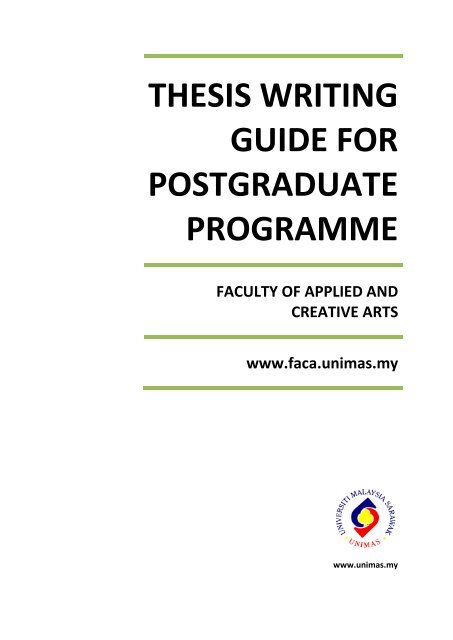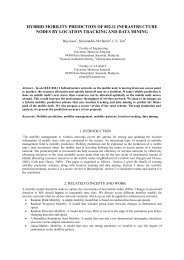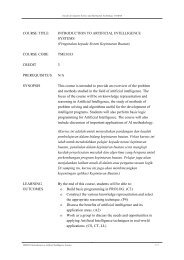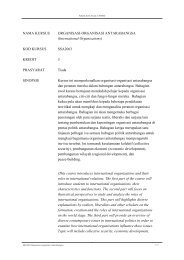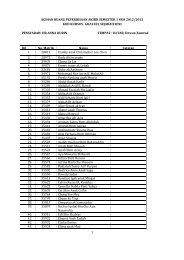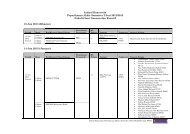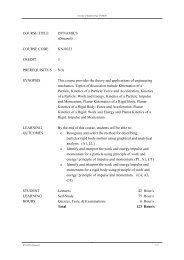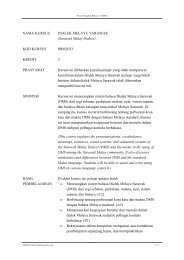Thesis Writing Guide - Faculty of Applied & Creative Arts - Universiti ...
Thesis Writing Guide - Faculty of Applied & Creative Arts - Universiti ...
Thesis Writing Guide - Faculty of Applied & Creative Arts - Universiti ...
You also want an ePaper? Increase the reach of your titles
YUMPU automatically turns print PDFs into web optimized ePapers that Google loves.
THESIS WRITINGGUIDE FORPOSTGRADUATEPROGRAMMEFACULTY OF APPLIED ANDCREATIVE ARTSwww.faca.unimas.mywww.unimas.my
2012<strong>Faculty</strong> <strong>of</strong> <strong>Applied</strong> and <strong>Creative</strong> <strong>Arts</strong><strong>Universiti</strong> Malaysia Sarawak93400 Kota SamarahanSarawak
<strong>Thesis</strong> <strong>Writing</strong> <strong>Guide</strong> For Postgraduate Programme:FACA v. 2012FACULTY OF APPLIED AND CREATIVE ARTSTHESIS WRITING GUIDE FOR POSTGRADUATE PROGRAMMEThis guide is designed to help the postgraduate students <strong>of</strong> <strong>Faculty</strong> <strong>of</strong> <strong>Applied</strong> and <strong>Creative</strong><strong>Arts</strong> in the preparation <strong>of</strong> their theses. It is further improved based on thesis guideline fromCentre for Graduate Study UNIMAS (CGS).A. REQUIREMENT OF THE THESIS1. Maximum Length Required(a) PhD <strong>Thesis</strong> - 100,000 words;(b) Master’s Dissertation - 60,000 words;Excluding footnote, appendices, tables, diagrams, references and bibliography2. Editorial ServiceCandidates are advisable and encouraged <strong>of</strong> using the editorial service as to checktheir words and sentences structure before the thesis is sent for examination.Supervisors are not responsible on editing the theses. Students should refer forlanguage expertise for the accuracy <strong>of</strong> translation and terminology. Theses that arereasonably free <strong>of</strong> errors will be accepted for examination.3. Conform to the set <strong>Guide</strong>linesCandidates are required to conform to the guidelines set by the <strong>Faculty</strong> and Centre forGraduate Study UNIMAS. Candidates are also required to keep the writing structureand format especially citation and referencing format <strong>of</strong> their theses accurate andconsistence. FACA encourage candidate to apply APA (American PsychologicalAssociation) System 5 th Edition for citation and referencing.B. FORMAT OF THE THESIS1. Language and Units1.1 The thesis must be written in either English or Bahasa Melayu. The language <strong>of</strong>the thesis should be as direct and simple, as the subject matter will allow.1.2 The English Language must conform to either fully in British or American style,but not a mixture <strong>of</strong> both.1.3 All units <strong>of</strong> measurement must be in the metric system.2. TypingChapter titles should be typed with capital letters and centered between the left andright margins. Each chapter must begin on a new page. Titles should be typed in boldwithout underline. Only the first letter <strong>of</strong> the first word <strong>of</strong> a sub-title should be inuppercase.1 | P a g e
2 | P a g e<strong>Thesis</strong> <strong>Writing</strong> <strong>Guide</strong> For Postgraduate Programme:FACA v. 20122.1 Font. Preferably, all candidates are to use Times New Roman (font size 12) intheir theses. In certain cases, use <strong>of</strong> other font types may be considered uponapproval by the <strong>Faculty</strong> Postgraduate Committee.2.2 Spacing. The thesis should by typed on one side <strong>of</strong> the page. The text should bedouble-spaced throughout the thesis. However explanatory footnotes, longquotations, appendices, headings and subheadings. legends, captions or keys totables, figures, or plates should be single-spaced.2.3 Type Quality. Both copies <strong>of</strong> the thesis submitted for examination and finalsubmission must be printed using a laser printer.3. MarginsThe top and bottom margins <strong>of</strong> all pages should be 3 cm wide, with the right and lefthandpage margin should be 2.5 cm wide.4. Pagination4.1 Pages should be numbered consecutively throughout the thesis, including pages<strong>of</strong> figures, tables and appendices. Pagination begins with the first page <strong>of</strong>Chapter 1. Preliminary pages (i.e. those preceding Chapter 1) must carry pagenumbers in small roman numerals (i, ii, iii, etc.). The title page should not benumbered.4.2 Page numbers should be centered at the bottom <strong>of</strong> the page and should be atleast 10 mm from the margin <strong>of</strong> the page. Page numbers should appear bythemselves and are not to be enclosed in parentheses, hyphens, etc. Eachappendix should be identified separately in alphabetical order. The pages <strong>of</strong> theappendices should also be typed according to the above pagination system.5. PaperWhite, good-quality <strong>of</strong> 80g A4 paper should be used for all submitted copies <strong>of</strong> thethesis. Photographic illustrations should be laser colour-printed on good quality highresolutionpaper.C. THE ARRANGEMENT OF THE CONTENTS OF THE THESISCandidates should bear in mind that thesis examiners deplore overlong or verbosethesis, and the onus is on the candidate to provide a well-organized and well-writtenthesis. The following ordered list <strong>of</strong> thesis sections serves as a guide.The Arrangement <strong>of</strong> the Contents <strong>of</strong> the <strong>Thesis</strong>No Section Requirement Remarks1 Blank Page - unnumbered2 Title Page (Appendix 1 ) require Unnumbered but consideredas (i)3 Author’s Declaration (Appendix2 )requireLowercase Roman Numeral(ii)
3 | P a g e<strong>Thesis</strong> <strong>Writing</strong> <strong>Guide</strong> For Postgraduate Programme:FACA v. 20124 Copyright (optional) Lowercase Roman Numeral5 Dedication (optional) Lowercase Roman Numeral6 Acknowledgement require Lowercase Roman Numeral7 Abstract require Lowercase Roman Numeral8 Table <strong>of</strong> Contents require Lowercase Roman Numeral9 List <strong>of</strong> Tables require Lowercase Roman Numeral10 List <strong>of</strong> Figures require Lowercase Roman Numeral11 List <strong>of</strong> Symbols andrequire Lowercase Roman NumeralAbbreviations12 List <strong>of</strong> Appendices require Lowercase Roman Numeral13 Text require Arabic Numeral14 References require Arabic Numeral15 Appendix require Arabic Numeral1. Title PageThe thesis title should be as concise as possible, giving an accurate description <strong>of</strong> thethesis. The title page must contain the following information in the following order:i. Title <strong>of</strong> the thesis;ii. Full name <strong>of</strong> the student;iii. Statement on the purpose <strong>of</strong> the thesis submission;iv. Name <strong>of</strong> the faculty or centre where the student is registered;v. Name <strong>of</strong> the University; andvi. The year the thesis was written and accepted.The standard format <strong>of</strong> the title page should be followed closely (APPENDIX 1).2. Author’s DeclarationThe declaration page contains a statement declaring the originality <strong>of</strong> the thesis. Itmust be signed by the author. Please refer to APPENDIX 23. Copyright (optional)Under International Law the use <strong>of</strong> copyright material requires the permission <strong>of</strong>either the author or the publisher. It is the responsibility <strong>of</strong> the candidate to addressthis issue and cover any expenses incurred.4. Dedication (optional)The author may wish to dedicate his/her work to the relevant person(s) tantamount tohis/her success in obtaining his/her degree.5. Acknowledgements/PrefaceMost theses will include a brief statement <strong>of</strong> gratitude in recognition <strong>of</strong> specialassistance (including financial) and guidance given by individuals, institutions orgovernment bodies.6. AbstractAbstracts in both Bahasa Melayu and English are mandatory. The English version mustinclude the title in English for a thesis written in Bahasa Melayu, and vice versa. Theabstract is a summary <strong>of</strong> the entire thesis. It should briefly outline the research
<strong>Thesis</strong> <strong>Writing</strong> <strong>Guide</strong> For Postgraduate Programme:FACA v. 2012problems addressed by the thesis, the findings, and the significance <strong>of</strong> the work in thecontext <strong>of</strong> the field <strong>of</strong> study. The abstract should not exceed four (4) typewrittendouble-spaced pages <strong>of</strong> text with font size <strong>of</strong> 12. Abstract in the language not used inthe body <strong>of</strong> the thesis should be written in italics.7. Table <strong>of</strong> ContentsThe titles <strong>of</strong> sections, chapters and their principal subdivisions along with the pagenumbers on which they appear should be listed in the Table <strong>of</strong> Contents. Titles shouldbe worded exactly as they appear in the text <strong>of</strong> the thesis. Theses with manysubsections should use a hierarchical numbering system for headings and subheadings(e.g. 3.0, 3.1, 3.2 etc). Such numbering system combined with the judicioususe <strong>of</strong> upper and lower case, indentations and italics should indicate clearrelationships between the sections <strong>of</strong> the thesis.8. Lists <strong>of</strong> Tables, Figures and PlatesThese lists consist <strong>of</strong> the exact titles (including numbering) <strong>of</strong> all tables, figures andplates that appear in the thesis. All tables, figures and plates should be numberedconsecutively throughout the text.9. List <strong>of</strong> Abbreviations, Symbols, Specialized NomenclatureThis list is optional, depending on the subject <strong>of</strong> the thesis. All scientific symbols andnomenclature should follow the standard SI system.10. Main Text <strong>of</strong> the <strong>Thesis</strong>The main body <strong>of</strong> the thesis is usually arranged into consecutively numbered chaptersor sections. The internal organization <strong>of</strong> the thesis is the responsibility <strong>of</strong> thecandidate in consultation with his/her thesis supervisor(s). The organization will partlydepend on the field <strong>of</strong> study, but the onus is on the student to provide a systematicand well-organized thesis. Overall, the font <strong>of</strong> the main text should be font 12 withdouble-spacing.There is no restriction on the total number <strong>of</strong> chapters in a thesis. Generally, a thesiswill have the following basic structure:10.1 IntroductionIt is the introductory chapter that introduces the problem and indicates itsimportance and validity. It sets forth the context, the hypothesis (if applicable)to be tested or research problems and the research objectives to be attained.10.2 Literature ReviewIt is a critical review <strong>of</strong> literature related to the topic <strong>of</strong> the thesis. It is meantto act as a base for the experimental/analytical section <strong>of</strong> the thesis. Literatureselected must be up to date, analysed and synthesised logically. It is not a meresummary <strong>of</strong> works <strong>of</strong> different authors.4 | P a g e
<strong>Thesis</strong> <strong>Writing</strong> <strong>Guide</strong> For Postgraduate Programme:FACA v. 201210.3 Materials and MethodsAll relevant experimental, descriptive, theoretical and analytical techniquesused in the research should be outlined, such that the study could be repeatedby another researcher. Reference <strong>of</strong> methods to other researchers should bemade where appropriate. This important chapter explains in detail thesamples, instruments, materials, procedures and data gathering methods usedin the research.10.4 Data Analysis and ResultsThis may be presented as a single chapter, divided into appropriate section, intwo or more separate chapters where it includes the analysis and presentation<strong>of</strong> data. The results should be interpreted, but extensive reference to otherrelevant work should not be included.10.5 Discussion, Summary and ConclusionsThis provides a general discussion on the results <strong>of</strong> the study, stressing thesignificance and implications <strong>of</strong> the findings <strong>of</strong> the research projectundertaken. Summary and Conclusions are drawn based on the researchfindings and their implications.It is acceptable for individual chapters to be self-contained, including their ownintroduction, methods, results and discussions, as is <strong>of</strong>ten the case where individualchapters are being submitted for publication. However, in such theses, a broaderintroduction to the whole thesis should be included to tie the chapters or sectionstogether and to provide the framework for the whole thesis.11. Layout for Tables, Figures or Plates11.1 TablesTables are numbered consecutively with Arabic numerals throughout the thesis(including text and appendices). There are two possible numbering schemes:either (a) number them consecutively throughout the thesis, or (b) numberthem by chapter, e.g. Table 1.1, 1.2, 1.3, 2.1, 2.2 and so on. Normally, all tablesare to be listed under LIST OF TABLES in the preliminary pages (including tablesappearing in the appendices). Tables should be placed after their firstmentioned in the text or placed at the end <strong>of</strong> each chapter. Table number, titleand caption are typed single-spaced and placed above or below the table.There should be consistency in the style used. Table sources and notes shouldbe placed directly below the caption. Vertical lines are permitted.5 | P a g e
<strong>Thesis</strong> <strong>Writing</strong> <strong>Guide</strong> For Postgraduate Programme:FACA v. 2012For Example:Table 1.1: Test <strong>of</strong> liquid absorb in 8 types <strong>of</strong> hand-made paper.Dipping Activities(time)Hand-madePaper (type)Diameter in cm (colourspreading)5 second5 second5 second5 second5 second5 second5 second5 secondABCDEFGH22.50.540.24.551Note: Using conventional watercolour pigment11.2 Figures or PlatesFigures or Plates include maps, charts, graphs, diagrams, photographs,engineering drawings and printed images. Each <strong>of</strong> these categories arenumbered consecutively or according to the chapter throughout the thesis,including those in appendices. The figure or plate number, title and captionshould be typed singles-paced and placed either below or at the top <strong>of</strong> thefigure using Arabic numeral and lowercase, except for Proper nouns and firstletters <strong>of</strong> principal words. Figures or Plates should be inserted after their firstmention in the text or at the end <strong>of</strong> each chapter. If a figure or plate occupiesan entire page, the caption may be typed on the left-hand facing page (reverseside blank), which is counted but not paginated. A right-hand page in landscapeformat should have the top <strong>of</strong> the figure at the binding edge. The figure orplate number should be typed parallel to the way the figure reads. The pagenumber is typed in standard text position. Figures or plates should conform tostandard margin requirements. Large size drawings or images should be placedin the appendix.For Example:Figure 1.1: <strong>Universiti</strong> Malaysia Sarawak Official Logo (Source: UNIMAS)6 | P a g e
<strong>Thesis</strong> <strong>Writing</strong> <strong>Guide</strong> For Postgraduate Programme:FACA v. 201212. Format for Measurement, Numbers, Marks and Brackets12.1 Units <strong>of</strong> MeasureUse internationally recognised units <strong>of</strong> measure, preferably SI, such as:i. litre (I L)ii. 30 millilitres (30 mL)iii. 15 kilogram (15 kg)iv. 500 U.S. Dollars (USD500)The numbers before the measurement units should not be spelt out, e.g. suchas 5 kg, not five kg even if they are below 100, unless they are the first word <strong>of</strong>sentences.12.2 NumbersAll integers less than ten should be spelt out unless they are attached to units<strong>of</strong> measure (e.g. 5 kg, 10 mL). Use figures for numbers 10 or more than 10. If asentence begins with a number, write the numbers in words, e.g. "Threehundred and eighty-five farmers were sampled from the study area." Usenumerals for a series <strong>of</strong> figures, for example:i. In the room there were 4 chairs, 12 boxes, 13 books, 10 files, 9 umbrellaand 8 pairs <strong>of</strong> shoes.ii. The number <strong>of</strong> taxi permits issued during the past five years was 8, 53, 27,38, 52, and 90.12.3 Elliptical MarksWriters use the ellipsis mark to show an omission from quoted material. Theellipsis consists <strong>of</strong> three-spaced full stops (...). When an ellipsis follows asentence, it appears as four full stops (. ...). One full stop marks the end <strong>of</strong> thesentence and the other three signal the omission. For example: Khatijah (1985:4) wrote about the conference: The conference at Kuala Lumpur . . . agreedthat the world educational crisis sketched in the document was real. . . .12.4 Use <strong>of</strong> Brackets [ ]Within direct quotations, brackets are used to enclose any explanatory noteinserted by the thesis writer, e.g. This year [1996] alone, we had two hundredapplicants wanting to join our holiday camp (Mustafa, 1996). Candidatesshould use "sic" within brackets [sic] to indicate a certain doubt as to meaningor factual error. It is used in quotations to show that the original is beingfaithfully reproduced even though it is incorrect or seems to be so. Errors,which are obviously typographical, should be corrected as a matter <strong>of</strong>pr<strong>of</strong>essional courtesy.13. Literature Citation and Referencing13.1 Any thesis, which makes use <strong>of</strong> other works, either in direct quotation or byreference, must contain a bibliography listing all <strong>of</strong> these sources. Only worksdirectly cited or quoted in the text should be included in the bibliography.13.2 UNIMAS follows either the Harvard or the APA System (American PsychologicalAssociation) for literature citation and referencing. However, FACA is strongly7 | P a g e
<strong>Thesis</strong> <strong>Writing</strong> <strong>Guide</strong> For Postgraduate Programme:FACA v. 2012suggest the students to apply APA System (American Psychological Association)5 th Edition.13.3 In the text, the year <strong>of</strong> publication appears within parentheses after theauthor’s surname if the latter forms part <strong>of</strong> a sentence; for example, Chong(1986) or Azis and Harrison (1987) or, where there are more than two authors,Yamakura et al. (1990). If several papers by the same author(s) and from thesame year are cited, the letters a, b, c, etc. should be put after the year <strong>of</strong>publication; for example: Chazdon and Ibrahim (1988b)13.4 Both the author’s surname and the year <strong>of</strong> publication appear withinparentheses if the author’s surname does not form part <strong>of</strong> a sentence; forexample: (Yakub & Chan, 1989).13.5 If a reference contains three authors, state all three names the first time it isreferred to in the text. For the second and subsequent times it is mentioned,state only the first author’s name followed by “et al.” and year.For example:A study by Alias, Black & Gray (2002) shows that engineering students havelower spatial visualisation ability than required. Since this ability is important insolving engineering problems, it needs to be improved among engineeringstudents (Alias et al., 2002).13.6 In any particular sentence, if several publications are cited, the referencesshould be cited in chronological order.13.7 However, if several publications <strong>of</strong> the same year are cited the referencesshould be cited in alphabetical order, with single author taking precedenceover joint authors.13.8 Reference from authorless articles should be cited as thus: (Anonymous, 1998).Reference from <strong>of</strong>ficial publications <strong>of</strong> international bodies/agencies should bewritten as thus: (WHO, 1984).13.9 SHORT QUOTATION - Words <strong>of</strong> an author may be quoted exactly by the writerto support an argument. When a direct quotation from a source is taken, itshould run into the text with double quotation marks if it is reasonably brief(three (3) or less sentences) with the end-<strong>of</strong>-sentence period in the normalplace.For example:Rajaratnam (2001) concluded that, “The cost to the nation’s health <strong>of</strong> workingout <strong>of</strong> phase with our biological clocks is probably incalculable at present.” (p.1000).For example:A lot <strong>of</strong> discussion has been made on the cost <strong>of</strong> working out <strong>of</strong> phase with ourbiological clocks. “The cost to the nation’s health <strong>of</strong> working out <strong>of</strong> phase with8 | P a g e
<strong>Thesis</strong> <strong>Writing</strong> <strong>Guide</strong> For Postgraduate Programme:FACA v. 2012our biological clocks is probably incalculable at present” (Rajaratnam, 2001, p.1000).LONG QUOTATION - A quotation containing more than three sentences mustbe set <strong>of</strong>f from the text as a paragraph on its own with 1 cm indent, placing theperiod at the end <strong>of</strong> the quoted text with no period after the reference citationpage number. Single spacing should be used for block quotations.For example:According to a renowned scholar (Rajaratnam, 2001),Biological time is not only scientifically important, but it alsogreatly affects the productivity and health <strong>of</strong> a nation. The cost tothe nation’s health <strong>of</strong> working out <strong>of</strong> phase with our biologicalclocks is probably incalculable at present. In the 19 short term,poor sleep, gastrointestinal problems, higher accident rate, andsocial problems are evident. (p. 1000)13.10 PARAPHRASING - The paraphrasing method is used to acknowledgeinformation taken from the original author by rewording the original textwithout altering its meaning nor providing the writer’s own interpretation.For example:Rajaratnam (2001) argues that while the notion <strong>of</strong> biological time is <strong>of</strong> scientificimportance, it is also economically and socially significant at a national level.He points to the health, productivity and social problems which may beattributed to individuals working “out <strong>of</strong> phase” with their internal clocks.13.11 SUMMARISING - The writer may summarise cited text in his/her own words topresent the key points <strong>of</strong> an author’s arguments or ideas, without altering themeaning.For example:In his conclusion, Rajaratnam (2001) points to the possible economic and socialcosts incurred by a nation, when individuals work “out <strong>of</strong> phase” with theirbiological clocks.13.12 At the end <strong>of</strong> the thesis, all the references cited are listed in alphabetical order.There is no necessity to number the references. The bibliography should bedouble-spaced as with the rest <strong>of</strong> the text with a size 11 font.13.13 Bibliographic examples (APA System):Reference from edited books:Race, P. (2002). How to Get a Good Degree: Making the Most <strong>of</strong> Your Time atUniversity. Buckingham: Open University Press.Reference by two or three authors:Creme, P. & Lea, M. R. (2003). <strong>Writing</strong> at University. 2nd ed. Maiden: OpenUniversity Press.9 | P a g e
<strong>Thesis</strong> <strong>Writing</strong> <strong>Guide</strong> For Postgraduate Programme:FACA v. 2012Delamont, S., Atkinson, P. & Parry, O. (2004). Supervising the Doctorate: A<strong>Guide</strong> to Success. 2nd ed. Maidenhead: Society for Research into HigherEducation & Open University Press.If the book has an editor, the name <strong>of</strong> the editor must also be written:Martin, A.M. (Ed.) (1991). Peat as an Agent in Biological Degradation <strong>of</strong> Waste.London: Elsevier.Articles from books:Lees, R. H. (Ed.) (1974). Chemical Nomenclature Usage. Chischester: EllisHorwood. pp. 314-362.Articles from journal:Mikac, N. & Branica, M. (1994). Complexation <strong>of</strong> trialkyllead withdiethyldithiocarbonate. Electroanalysis, 6(2), pp. 37 – 43.Proceedings:Author (Year). Title. Proceeding. Location: Publisher. Page numbers.For example;Alias, M. (2006). The Effects <strong>of</strong> Teacher Generated Concept Maps on theLearning <strong>of</strong> Secondary School Physics. Proc. <strong>of</strong> the Second Int. Conf. onConcept Mapping. San Jose. Universidad de Costa Rica. pp. 550-557.Newspaper clippings:Author (Date). Title <strong>of</strong> article. Name <strong>of</strong> newspaper. Page numbers.For example;Latiff, A. B. A. (2001, Februari 14). Hatinya telah dimiliki. Utusan Mingguan. p.12.Translated sources:Original author's name. (Year <strong>of</strong> translation). Title <strong>of</strong> book (Name <strong>of</strong> translator,Trans.). Place <strong>of</strong> publication: Publisher. (Original work published Date)For example;Freud, S. (1970). An outline <strong>of</strong> psychoanalysis (Strachey, J., Trans.). New York:Norton. (Original work published 1940)Interview:A not considered to be recoverable data, so no reference to interviews shouldbe provided in the reference list. You may, however, cite the interview withinthe text as a personal communication.For example;...students are not interested in community services (Hassan, A. R., personalcommunication, August 15, 2006)Retrieved from internet:American Psychological Association (2011). What’s New in the Sixth Edition <strong>of</strong>the Publication Manual. Retrieved from http://www.apastyle.org10 | P a g e
<strong>Thesis</strong> <strong>Writing</strong> <strong>Guide</strong> For Postgraduate Programme:FACA v. 201214. AppendicesThis section is optional and will depend on the individual thesis content. It containssupplementary illustrative material, original data and quotations too long for inclusionand not immediately essential to an understanding <strong>of</strong> the subject. Appendix materialsshould be grouped by type, e.g. Appendix A: Questionnaire, Appendix B: Original Data,Appendix C: Result Tables. The appendices should be labelled alphabetically.D. BINDING, HARD COVER AND FINAL SUBMISSIONBinding <strong>of</strong> the thesis shall be the responsibility <strong>of</strong> the candidate.1. <strong>Thesis</strong> For ExaminationStudents are required to submit 2 copies <strong>of</strong> ring bound thesis in s<strong>of</strong>t cover prior toexamination by the internal and external examiners. Theses submitted must beapproved by the main supervisor.2. Hard Bound <strong>Thesis</strong> and Front CoverFollowing acceptance and approval by the Graduate Studies Committee the thesisshould be bound in hard cover. On the final hard bound copies, the title <strong>of</strong> the thesis,name <strong>of</strong> candidate and the degree for which the thesis is submitted should be printedon the front cover according to the format required (Appendix 3). The front cover <strong>of</strong>the theses shall be printed according to the colour <strong>of</strong> the <strong>Faculty</strong>/Institute togetherwith the UNIMAS logo and the name <strong>of</strong> the <strong>Faculty</strong>/Institute. The student’s name,degree and year shall also be printed on the spine <strong>of</strong> the bound thesis. Stripesaccording to the colour <strong>of</strong> the faculty, institute or center shall be printed on the backcover and spine to distinguish between a PhD (3 stripes) and Master (2 stripes) thesis(Appendix 4). Candidates are advised to consult the Centre for Graduate Studies forthe final submission <strong>of</strong> thesis.3. Final SubmissionStudents are required to do 5 copies <strong>of</strong> approved thesis and submit to Centre forGraduate Study, UNIMAS. CGS then will verify the copies and students are required tocomplete the Final Submission Form. CGS will keep 3 copies <strong>of</strong> student theses.Students are also encouraged to submit a copy <strong>of</strong> their thesis to main supervisor.Additional requirement – students are required to submit a copy <strong>of</strong> electronicdocument (compile as one file in PDF format) <strong>of</strong> their thesis to CGS.REFERENCESAmerican Psychological Association (2004). Publication Manual <strong>of</strong> the AmericanPsychological Association. 5th edition. Wisconsin, USA: George Banta Comp.Dewan Bahasa dan Pustaka (1990). Gaya Dewan Bahasa. Kuala Lumpur.11 | P a g e
<strong>Thesis</strong> <strong>Writing</strong> <strong>Guide</strong> For Postgraduate Programme:FACA v. 2012<strong>Universiti</strong> Putra Malaysia (2005), <strong>Guide</strong> to the Preparation <strong>of</strong> <strong>Thesis</strong>, School <strong>of</strong> GraduateStudies UPM<strong>Universiti</strong> Tun Hussein Onn Malaysia (2012), <strong>Thesis</strong> <strong>Writing</strong> <strong>Guide</strong>, Centre for GraduateStudies UTHM.12 | P a g e
APPENDIX 1: Page Title<strong>Thesis</strong> <strong>Writing</strong> <strong>Guide</strong> For Postgraduate Programme:FACA v. 2012TITLE OF THE THESISNAMEA thesis submittedin fulfilment <strong>of</strong> the requirements for the degree <strong>of</strong>Master <strong>of</strong> <strong>Arts</strong>/ Doctor <strong>of</strong> Philosophy<strong>Faculty</strong> <strong>of</strong> <strong>Applied</strong> and <strong>Creative</strong> <strong>Arts</strong><strong>Universiti</strong> Malaysia SarawakYear13 | P a g e
APPENDIX 2: Author’s Declaration<strong>Thesis</strong> <strong>Writing</strong> <strong>Guide</strong> For Postgraduate Programme:FACA v. 2012AUTHOR’S DECLARATIONI declare that the work in this thesis was carried out in accordance with the regulations <strong>of</strong><strong>Universiti</strong> Malaysia Sarawak. It is original and is the result <strong>of</strong> my work, unless otherwiseindicated or acknowledged as referenced work. This thesis has not been submitted at<strong>Universiti</strong> Malaysia Sarawak or to any other academic institution or non-academic institutionfor any other degree or qualification.Name <strong>of</strong> Student :Student ID No :Programme Degree :<strong>Faculty</strong> :<strong>Thesis</strong> Title :Signature <strong>of</strong> Student :Date :14 | P a g e
APPENDIX 3: Front Cover<strong>Thesis</strong> <strong>Writing</strong> <strong>Guide</strong> For Postgraduate Programme:FACA v. 201215 | P a g e
APPENDIX 4: Back Cover and Spine<strong>Thesis</strong> <strong>Writing</strong> <strong>Guide</strong> For Postgraduate Programme:FACA v. 201216 | P a g e


